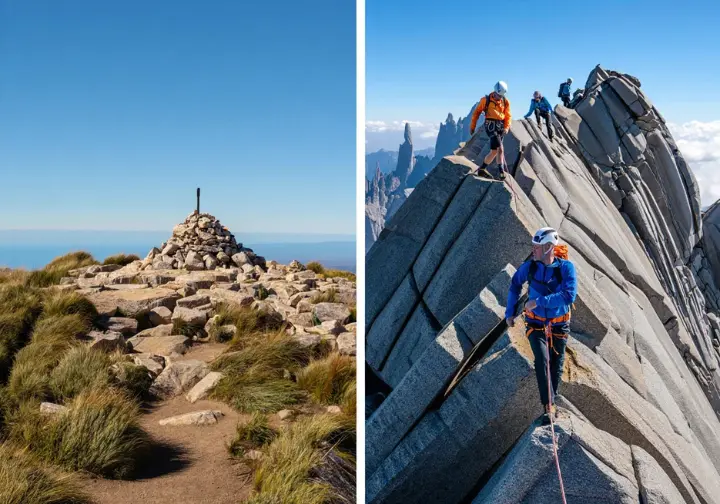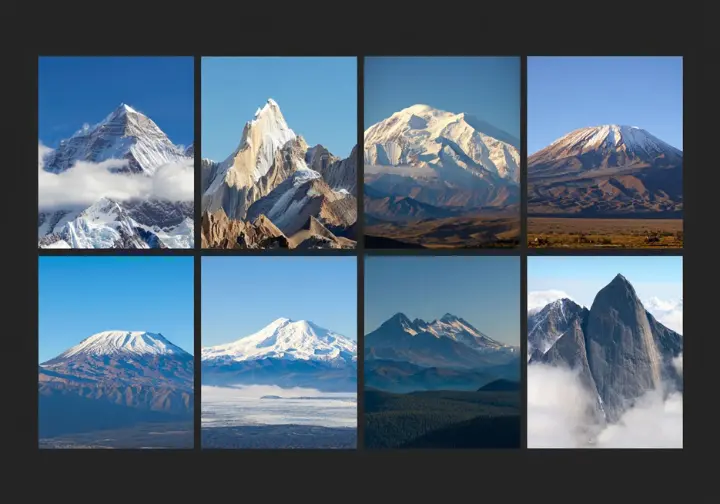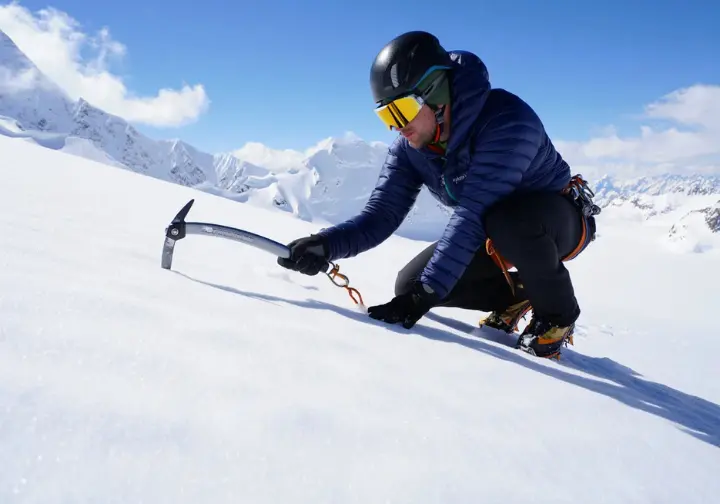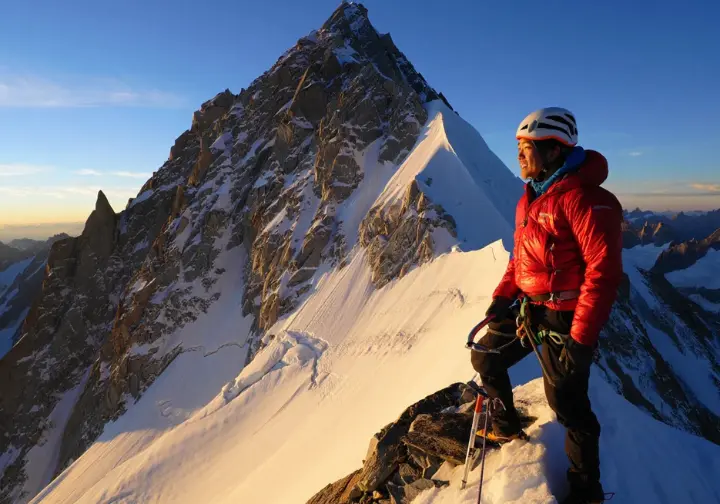In this article
This guide explores the seven summit of the world – the monumental quest to stand atop the highest point on every continent. A powerful draw for mountaineers worldwide, it represents a journey across diverse landscapes and formidable challenges. We’ll explore its origins, dissect the famous Bass versus Messner list debate, profile the peaks involved, and examine the practicalities and ethics of undertaking such a seven–summit adventure. Are you ready to map out the ultimate world summit challenge?
Defining the Global Quest

Embarking on the Seven Summits means committing to a significant undertaking, distinct from other high-altitude pursuits. This section charts the course of how this iconic challenge captured the imagination of climbers and adventurers across the world.
Origin of the Challenge
The Seven Summits challenge involves reaching the highest mountain on each continent, a goal distinct from tackling the 14 tallest mountains in the world, all clustered in Asia. It has become a celebrated objective for many mountaineers, fostering a unique community spirit among those who pursue these top peaks. Despite some debate within elite circles, its appeal remains strong for those seeking a profound global mountaineering achievement across the seven continents.
While the idea wasn’t entirely new—climbers like William Hackett reached several continental high points in the mid-20th century—the concept truly gained traction thanks to Richard Bass and Frank Wells in the early 1980s. Their pursuit defined the challenge for a wider audience, popularizing the quest and showing that this grand goal was attainable, even for non-professional climbers setting out on a major expedition.
The core of the challenge is reaching the highest summit on each continent, but defining these points sparked debate early on. This ambiguity arises from differing geographical interpretations, especially regarding the vast Australian continent and Oceania. Grasping this context is essential for understanding the different paths climbers can take.
An informal “Seven Summits Club” unites climbers sharing this passion, adding a layer of camaraderie to the demanding climb. This community reflects the quest’s international nature, connecting individuals across cultures. It underscores the shared experience of facing diverse environments, from Himalayan heights to Antarctic cold, demanding adaptability and resolve on each unique mountain peak.
Bass and Wells Initiative
Richard “Dick” Bass, a Texas businessman, alongside Frank Wells, who would later lead The Walt Disney Company, envisioned being the first to climb the highest mountain on each continent according to their specific list. Their backgrounds as successful entrepreneurs, not professional mountaineers, made their ambitious goal particularly resonant with the public. This narrative was key to the challenge’s initial surge in popularity.
Bass selected Mount Kosciuszko as the highest peak for the Australian continent, aligning with a common geographical view. This choice made the list slightly less technically intimidating. It presented a version of the seven summits that felt more within reach for a broader group of aspiring adventurers, focusing on the mainland definition.
With considerable determination and the help of professional mountain guides, Bass achieved his goal by summiting Mount Everest on April 30, 1985. He became the first person documented to complete the Seven Summits based on his chosen list, a pivotal moment that greatly popularized the challenge. His success inspired countless others to consider this epic peak bagging adventure.
Following their success, Bass, Wells, and mountaineer Rick Ridgeway co-authored the book “Seven Summits.” This bestseller amplified public interest significantly, detailing their journey’s highs and lows and cementing the Seven Summits in the collective imagination. The book was instrumental in fueling the commercial guiding industry around the summit challenge.
The story of determination triumphing over relative inexperience struck a chord, though some noted that wealth enabled significant support (“buying their way to the top”). Yet, this perceived accessibility, driven by the Bass/Wells narrative and their specific summits list, was crucial. It opened doors for commercial expeditions catering to those dreaming of becoming seven summiters.
Bass vs Messner Lists

At the heart of the Seven Summits lies a fascinating divergence: the two primary lists defined by Richard Bass and Reinhold Messner. This section navigates the core of the debate, stemming from how one defines the seventh continent and its corresponding highest peak.
The Two Competing Lists
The Bass List, often called the Kosciuszko List, was the first completed version (by Richard Bass in 1985). It includes Mount Kosciuszko as the highest peak for Australia. The full roster features Everest (Asia), Aconcagua (South America), Denali (North America), Kilimanjaro (Africa), Elbrus (Europe), Vinson Massif (Antarctica), and Kosciuszko (Australia), defining the seventh continent as mainland Australia.
Conversely, the Messner List, or Carstensz List, substitutes Australia’s summit with Puncak Jaya (Carstensz Pyramid) in Oceania/Australasia. Championed by the legendary mountaineer Reinhold Messner and first completed by Canadian Patrick Morrow in 1986, this list comprises Everest, Aconcagua, Denali, Kilimanjaro, Elbrus, Vinson, and Puncak Jaya. It reflects a broader geographical interpretation favored by many experienced climbers.
The crucial difference rests solely on this seventh summit choice, representing either the Australian continent (Kosciuszko) or the wider Oceania region (Carstensz Pyramid). This single substitution dramatically alters the overall difficulty, technical skill required, cost, and logistics. It forms the crux of the enduring “Seven Summits debate” within the mountaineering community.
Presently, both the Bass and Messner lists are generally accepted as valid interpretations. No official body dictates one over the other, acknowledging the different philosophies underpinning each summits list. Climbers can select the path aligning with their personal goals, resources, and interpretation of the continents.
Reflecting this ambiguity, many ambitious mountaineers choose to climb all eight—summits featured across both lists: Everest, Aconcagua, Denali, Kilimanjaro, Elbrus, Vinson, Kosciuszko, and Carstensz Pyramid. This definitively satisfies both criteria. Some even add Mont Blanc, addressing a minor European peak question, totaling nine summits.
Continental Definition Debate
The case for Mount Kosciuszko (2,228 m / 7,310 ft) hinges on defining the continent as the mainland Australian landmass. This aligns with common political and geographical views. Kosciuszko is the undisputed highest mountain in mainland Australia and technically straightforward, often achievable as a day hike. This perspective prioritizes a common-sense definition.
The argument for Puncak Jaya / Carstensz Pyramid (4,884 m / 16,024 ft) employs a broader scope, considering either the Australian continental plate (the Sahul continental shelf) or the region of Oceania, which includes New Guinea where the peak lies. This geological or regional view identifies a significantly higher and more technically demanding summit for the seventh continent.
Advocates of the Messner list, like Messner and Patrick Morrow, argued Carstensz Pyramid offers a more fitting “mountaineer’s objective.” Its greater height and technical rock climbing challenge (requiring skills up to grade V/VI UIAA) stand in contrast to Kosciuszko’s relative ease, often described as “just a walk.” They felt it better represented the highest mountain in oceania.
The absence of a single, universally agreed-upon definition of a continent among geographers allows this debate to persist. Different scientific and cultural perspectives permit both interpretations to coexist. This inherent ambiguity is fundamental to the two-list system that defines the seven summits of the world.
A similar, less prominent, discussion exists regarding Europe’s highest peak: Mount Elbrus (5,642 m) versus Mont Blanc (4,810 m). This stems from varying definitions of the Europe-Asia continental boundary. Elbrus, included in both lists and endorsed by Messner, is the generally accepted standard for the European continent.
Key Figures Shaping Lists
Richard Bass acted as the catalyst, popularizing the Seven Summits through his successful completion of the Kosciuszko list. His subsequent book detailed an accessible adventure, defining the challenge for a mainstream audience and emphasizing the journey of a determined non-professional. His choice of Kosciuszko made the goal seem more attainable for many climbers.
Frank Wells was Bass’s indispensable partner in the initial conception and execution of the Seven Summits quest. Although Bass reached the final summit first, Wells was integral to the project’s origins and the compelling narrative that captured public interest. Their partnership highlighted the collaborative spirit often needed for such ambitious expeditions.
Reinhold Messner, an elite alpinist celebrated as the first to climb all 14 tallest mountains in the world (the eight-thousander peaks), championed the Carstensz list, lending it significant credibility. His advocacy stemmed from a broader geographical scope (Oceania) and a preference for a more demanding technical mountaineering expedition, aligning with purist alpinist values.
Patrick Morrow, a Canadian climber, became the first person to complete the Messner (Carstensz) list in 1986, shortly after Bass finished his. Morrow also believed Carstensz was the more appropriate representation of the region’s high point and a truer test for mountaineers. His completion validated the Messner list as an achievable, albeit more difficult, alternative summit challenge.
The contrasting perspectives of Bass (businessman adventurer) and Messner (purist alpinist) encapsulate the core tension: accessibility versus technical difficulty. Bass’s list fueled popular interest and commercialization, while Messner’s appealed more to seasoned climbers seeking a greater test, a philosophical divide still influencing approaches to the 7 mountains to climb.
Profiling the Eight Peaks

This section offers a glimpse into the distinct character of each of the eight mountains spanning the Bass and Messner lists. We’ll touch upon their location, elevation, and the unique challenges they present to those aiming for the seven summiters title.
Giants: Everest & Aconcagua
Mount Everest (8,848.86 m / 29,031.7 ft), straddling the Nepal-China border, reigns as the world’s highest mountain peak, representing Asia on both lists. Climbing it involves confronting the “Death Zone,” objective dangers like the Khumbu Icefall, severe weather, and a lengthy duration (around 2 months). It’s typically the final, most demanding summit. The main routes ascend from Nepal (South Col) or Tibet (North Ridge).
Aconcagua (6,960.8 m / 22,837 ft) in Argentina stands as South America’s highest peak and the tallest outside Asia, included on both lists. While its Normal Route is non-technical—essentially a high-altitude trek—the extreme altitude, ferocious winds (“viento blanco”), and cold pose serious challenges. These factors contribute to a significant failure rate, making it crucial high altitude experience for aspiring Everest climbers.
Both Everest and Aconcagua demand meticulous acclimatization strategies due to their extreme altitudes. Altitude sickness (AMS, HAPE, HACE) is a major risk, requiring careful ascent profiles. Proper preparation for altitude is more critical than technical skill on Aconcagua’s Normal Route, a lesson some learn the hard way. Many underestimate the thin air here.
Everest expeditions are substantially longer (approx. 2 months) and vastly more expensive ($35k-$200k+) than Aconcagua trips (approx. 3 weeks, $4k-$14k+). The logistical complexity, high permit fees, oxygen use, and extensive support needed for Everest explain its steep cost, placing it in a different league financially.
Prominence is a defining feature for both; Everest is the world’s most prominent mountain, and Aconcagua ranks second. This topographical distinction highlights their massive vertical rise from surrounding terrain, reinforcing their status as continental highpoints. Aconcagua’s prominence underscores its stature as the highest peak in the Western and Southern Hemispheres.
North American & African Peaks
Denali (6,190 m / 20,310 ft), formerly Mount McKinley, is the apex of the North American continent, located in Alaska, USA, and features on both lists. It’s notorious for extreme cold, unpredictable weather, and its high latitude location (making the air feel thinner). The demanding expedition style requires hauling heavy loads and sleds on glaciers. Careful planning is essential for any Denali attempt. The West Buttress is standard but still formidable.
Kilimanjaro (5,895 m / 19,341 ft) in Tanzania is Africa’s highest peak and the world’s tallest free-standing mountain, included on both lists. Technically the easiest of the Seven Summits, standard routes like Machame or Lemosho involve high-altitude trekking with no technical mountaineering skills required. The primary hurdle is successfully acclimatizing to the significant altitude gain.
Denali is often ranked among the toughest Seven Summits due to this combination of factors. It demands advanced skills like glacier travel, crevasse rescue, and fixed line use, plus extensive cold-weather camping experience. Success rates hover around 40-60%, reflecting its difficulty. Expeditions typically last about three weeks, testing endurance and resilience.
Kilimanjaro’s difficulty hinges almost entirely on altitude adaptation. Success rates vary dramatically with route duration, from below 30% on rushed 5-day itineraries to over 95% on recommended 8-9 day treks allowing better acclimatization. Good hiking fitness is necessary, especially for the long summit day push. Have you considered how you’d approach acclimatization on a peak like Kilimanjaro?
Denali’s prominence (6,155 m) is third globally, emphasizing its massive rise. Kilimanjaro’s prominence (5,885 m) ranks fourth, highlighting its status as the tallest free-standing mountain, soaring dramatically from the surrounding plains. These figures underscore their continental significance.
Costs differ greatly: Denali expeditions range from $6,500 to $12,000+, reflecting Alaskan logistics. Kilimanjaro treks usually cost $2,000 to $5,000+, including substantial park fees but benefiting from established tourism infrastructure. Choosing a reputable operator is key for both safety and success.
European & Antarctic Summits
Mount Elbrus (5,642 m / 18,510 ft), in Russia’s Caucasus Mountains, is Europe’s highest peak and part of both lists. The standard South Route often uses lifts partway, involving moderate snow slopes. While requiring basic snow/ice skills (crampons, ice axe), the main dangers are altitude, extreme cold, and notoriously severe, unpredictable weather that can create whiteout conditions instantly.
Vinson Massif (Mount Vinson) (4,892 m / 16,050 ft) is Antarctica’s highest point, deep within the Ellsworth Mountains, and included on both lists. The climb is moderately technical, often compared to Rainier or Denali, involving glacier travel and fixed ropes. The primary challenges are the extreme, persistent cold (average -30°C), high winds, remoteness, and complex, costly logistics. It is the highest mountain in antarctica.
Elbrus serves as a good introduction to higher altitude peaks like Aconcagua or Denali, requiring fundamental skills often learned during the trip. Despite high reported success rates (80%+), fatalities occur yearly, frequently when climbers get lost in sudden blizzards. Navigation skills are paramount here, even on standard routes.
Vinson demands solid prior mountaineering experience, particularly in glacier travel, crevasse rescue, and cold-weather survival. Its extreme remoteness and the expense of Antarctic logistics make it one of the costliest Seven Summits ($45k-$75k+). Consequently, it’s often attempted later in a climber’s summit challenge sequence.
Elbrus expeditions are relatively short (7-12 days) and less expensive ($1.5k-$4k+) compared to other major summits. Access, however, can be complicated by geopolitical factors affecting travel to the region. Huts are commonly used on the South Route, offering some respite from the elements.
Vinson expeditions typically last 2-3 weeks during the Antarctic summer (Nov-Jan), featuring 24-hour daylight. Access involves charter flights from Chile to Union Glacier, then ski-planes to Base Camp, contributing significantly to the high price tag. Weather delays are common and must be factored in.
Both Elbrus (4,741 m prominence, 10th globally) and Vinson (4,892 m prominence, 8th globally) possess significant topographic prominence. This reinforces their status as continental highpoints. Elbrus is also one of the Volcanic Seven Summits, adding another layer to its appeal for some peak-baggers.
Oceania Contenders (Carstensz/Kosciuszko)
Puncak Jaya / Carstensz Pyramid (4,884 m / 16,024 ft) in Papua, Indonesia, represents Oceania/Australasia on the Messner list. It’s the world’s highest island peak. It is widely regarded as the most technically demanding of the Seven Summits due to sustained rock climbing (up to 5.8 US / V/VI UIAA) on sharp limestone, significant exposure, and the use of fixed ropes including a Tyrolean traverse near the summit.
Mount Kosciuszko (2,228 m / 7,310 ft) in New South Wales, Australia, is the highest mountain in mainland Australia and represents the continent on the Bass list. It is by far the easiest of the eight peaks, involving a straightforward day hike on well-maintained tracks in summer conditions. It requires only basic hiking fitness and presents minimal technical challenges.
Carstensz expeditions face major logistical hurdles beyond the technical climb: extreme remoteness, regional political instability, complex permits, and historically, a dangerous jungle trek approach (now often bypassed by costly helicopter flights). Frequent rain and wet conditions add another layer of difficulty to this already challenging ascent.
Kosciuszko, in contrast, demands only basic hiking fitness during summer. In winter (June-Oct), it becomes snow-covered, requiring skis or snowshoes and alpine safety awareness (navigation, avalanche risk). The main costs are minimal: park entry fees and perhaps an optional chairlift ticket, making it highly accessible.
Carstensz expeditions (using helicopter access) typically last 11-15 days and are expensive ($17k-$24k+) due to intricate logistics, permits, and access complexities. The summit day itself is exceptionally long (12-18 hours), testing endurance alongside technical skill.
Kosciuszko is usually climbed in a single day (4-8 hours return hike). The stark contrast in ease and accessibility compared to Carstensz highlights the fundamental difference the choice of the seventh summit makes to the overall Seven Summits challenge. It truly shapes the nature of the entire quest.
Both Carstensz Pyramid (4,884 m prominence, 9th globally) and Mount Kosciuszko (2,228 m prominence) are the most topographically prominent peaks of their respective domains (New Guinea island / Australian mainland). This underscores their significance as the highest points within their defined geographical areas.
Understanding the Seven Summit of the World Challenge

Pursuing the Seven Summits is more than just ticking off peaks; it’s a multi-year commitment involving a spectrum of difficulties, rigorous preparation, substantial financial outlay, and inherent dangers. This section breaks down these practical realities.
Difficulty Spectrum Ranked
The eight peaks involved in the Seven Summits lists span an immense range of difficulty, from a simple walk-up to extreme high-altitude mountaineering. A generally accepted (though subjective) ranking from easiest to hardest is: Kosciuszko, Kilimanjaro, Elbrus, Aconcagua, then a cluster of Denali/Vinson/Carstensz (whose order is debatable), and finally, Everest.
Kosciuszko stands alone as the easiest, requiring only basic hiking fitness in summer. Kilimanjaro follows, primarily posing an altitude challenge rather than a technical one. Elbrus introduces basic snow/ice skills and significant weather risk, demanding respect despite its accessibility. It’s a step up in commitment.
Aconcagua represents a major leap due to extreme altitude effects, severe cold, and high winds. It demands significant endurance, even though the normal route is non-technical. Its difficulty is frequently underestimated, contributing to relatively low success rates among climbers attempting this peak.
Denali, Vinson, and Carstensz form the next tier. Denali combines high altitude/latitude, extreme cold, harsh weather, and the physical toll of hauling heavy loads. Vinson features brutal cold, remoteness, and high logistical costs. Carstensz requires technical rock climbing skills and faces complex logistical and political hurdles. Which of these sounds like the biggest challenge to you?
Everest remains the ultimate test due to its extreme altitude (“Death Zone”), objective hazards like the Khumbu Icefall and avalanches, severe weather, long duration, and high cost. It demands extensive prior experience and mastery of high-altitude mountaineering skills, often representing the culmination of years of dedication.
Opting for the Messner list (Carstensz) significantly elevates the overall technical difficulty compared to the Bass list (Kosciuszko). This choice fundamentally alters the skill set required to complete the full seven summits challenge. The difficulty isn’t solely about altitude but a complex interplay of factors unique to each mountain.
Essential Training Preparation
Preparation must align with each peak’s specific demands, progressing logically. Basic hiking endurance suffices for Kosciuszko and Kilimanjaro, but the journey quickly escalates towards advanced mountaineering expertise for the higher, more technical summits. Kilimanjaro primarily requires cardiovascular fitness for multi-day trekking at altitude.
Elbrus necessitates proficiency with crampons and ice axe (self-arrest, walking) and understanding basic rope travel. These skills are often taught or refreshed during the expedition. Aconcagua training heavily emphasizes high-altitude endurance, cardiovascular fitness, and the strength needed for carrying packs over extended periods at altitude.
Denali, Vinson, Carstensz, and Everest demand significant prior experience, typically including successful climbs of 6000m+ peaks (like Aconcagua or Himalayan peaks). Advanced skills in glacier travel, crevasse rescue, steep snow/ice climbing, fixed line ascent (jumaring), rappelling, and snow anchor building become mandatory prerequisites for these serious expeditions.
Specialized skills are vital for certain summits: Carstensz requires comfort with exposed technical rock climbing, while Denali and Vinson demand exceptional cold-weather camping and survival expertise. Physical conditioning must be climb-specific, emphasizing endurance hiking with heavy packs and targeted strength training. Building this foundation takes time and dedication.
Mental fortitude is just as critical as physical fitness, particularly on long, arduous expeditions like Denali and Everest. Climbers need resilience to cope with discomfort, stress, weather delays, and the ability to function effectively within a team under pressure. Many guide services offer or require preparatory courses to build these skills.
Investment: Costs Involved
The total financial commitment for the Seven Summits varies enormously. Costs range from minimal for Kosciuszko (<$250) to potentially exceeding $200,000 for a high-end Everest expedition. The overall cost for a guided completion of either the Bass or Messner list typically runs well into six figures, representing a major life investment.
Estimated average guided costs place the Bass list total around $145,000+ and the Messner list total around $162,750+. These figures exclude international flights, specialized insurance, personal climbing gear (which can add $5k-$30k), and training expenses. Budget options might lower base costs but could compromise support levels.
Key cost drivers differ by peak. Everest costs are inflated by permits, oxygen, extensive Sherpa support, and complex logistics. Vinson’s high price ($45k-$75k+) stems almost entirely from the extreme expense of Antarctic flights and base camp operations. Carstensz costs ($17k-$24k+) reflect helicopter access, remote Papua logistics, permits, and security considerations.
Mid-range peaks show variability: Denali ($6.5k-$12k+) costs reflect Alaskan logistics. Aconcagua ($4k-$14k+) varies based on duration and support. Elbrus ($1.5k-$4k+) is relatively inexpensive but subject to geopolitical access issues. Kilimanjaro ($2k-$5k+) costs are influenced by route duration and operator quality, with park fees being a significant portion.
It’s crucial to factor in often-overlooked expenses. International airfare, mandatory specialized travel/rescue insurance, high-altitude clothing and equipment (purchase or rental), visa fees, vaccinations, and pre-trip training programs add substantially to the total investment required for the seven summits of the world. Careful financial planning over several years is usually necessary.
Success Rates and Risks
Summit success rates vary widely across the peaks. They are influenced by route choice, weather windows, acclimatization schedules, operator quality, and individual preparedness. Everest rates have improved recently (~60-70%) due to better support and forecasting, but it remains inherently dangerous with significant objective hazards.
Aconcagua often sees lower success rates (30-60%) as climbers underestimate the severe altitude and weather, despite its non-technical nature. Denali’s rates (40-60%) reflect its harsh arctic conditions and demanding nature. Kilimanjaro success heavily depends on route length, ranging dramatically from <30% on short itineraries to >95% on longer, well-paced ones.
Elbrus is often cited with high success rates (80%+) but tragically experiences a significant number of fatalities yearly, usually due to climbers getting lost in sudden storms. Vinson and Carstensz frequently report very high success rates (e.g., 99%), likely reflecting stringent vetting (skills, cost) and high support levels, rather than inherent ease. Kosciuszko success is near 100% in good conditions.
Major risks across the Seven Summits include altitude sickness (AMS, HAPE, HACE), particularly critical on Everest, Aconcagua, Denali, Kilimanjaro, and Elbrus. Extreme weather—cold, wind, storms—is a primary danger on Everest, Denali, Vinson, Elbrus, and Aconcagua, capable of changing conditions rapidly and trapping climbers.
Objective hazards like avalanches, crevasse falls (especially on Denali, Vinson, Elbrus, Everest), serac collapse (like in Everest’s infamous Khumbu Icefall), and rockfall (a concern on Carstensz) pose significant threats. Logistical risks (remoteness, flight delays) are high for Vinson and Carstensz, while political instability is a specific concern for Carstensz expeditions.
Beyond the Main Quest

The iconic Seven Summits challenge has not only captivated generations of climbers but has also inspired related adventures and highlighted crucial modern considerations for responsible mountaineering.
Related Summit Challenges
The Seven Summits concept paved the way for similar global mountaineering objectives. One notable example is the Seven Second Summits, involving climbing the second-highest peak on each continent. This formidable list typically includes giants like K2 (Asia), Ojos del Salado (South America), Mount Logan (North America), Dykh-Tau (Europe), Mount Kenya (Africa), and Mount Tyree (Antarctica).
The Second Seven Summits challenge is widely considered significantly more difficult overall than the first Seven Summits. This is largely because K2 is far more dangerous and technically demanding than Everest. Additionally, Mount Kenya requires technical rock climbing unlike Kilimanjaro, and peaks like Dykh-Tau and Mount Tyree are generally harder than Elbrus and Vinson, respectively.
Another popular variation is the Volcanic Seven Summits, targeting the highest volcano on each continent. This list usually features Ojos del Salado (South America – world’s highest volcano), Kilimanjaro (Africa), Elbrus (Europe), Pico de Orizaba (North America), Mount Damavand (Asia), Mount Giluwe (Oceania), and Mount Sidley (Antarctica). These offer unique geological appeal.
Kilimanjaro and Elbrus appear on both the standard Seven Summits and the Volcanic Seven Summits lists. Ojos del Salado features on both the Volcanic and Second Seven Summits lists. These related challenges provide alternative goals for climbers seeking global quests beyond the original Bass/Messner lists, appealing to different interests and skill sets.
Further variations exist, such as the Volcanic Second Seven Summits, demonstrating the enduring appeal of continent-based peak-bagging challenges. These lists often involve even more obscure and logistically complex peaks, attracting climbers seeking unique adventures off the beaten path and pushing the boundaries of exploration.
Modern Ethical Considerations
The growing popularity of the Seven Summits, fueled partly by commercial expeditions, exerts significant environmental pressure on fragile mountain ecosystems. Issues include waste accumulation (human waste, abandoned gear), trail erosion, water contamination, and habitat disruption. This paradoxically threatens the very wilderness experience climbers seek.
Waste management poses a major challenge, especially at high camps on popular peaks like Everest. Abandoned tents, oxygen cylinders, and garbage accumulate, creating eyesores and environmental hazards. Efforts like stricter pack-it-out policies and cleanup expeditions are underway, but the task remains immense at extreme altitudes where removal is difficult and costly.
Overtourism, particularly on Everest and Kilimanjaro during peak seasons, raises safety concerns (e.g., dangerous queues near Everest’s summit) and diminishes the sense of remoteness. Managing climber numbers through permit systems is one strategy employed or considered by authorities in various countries to mitigate crowding and its impacts.
Social and economic impacts are also critical. Ensuring fair wages, safe working conditions, and proper treatment for local mountain guides and porters, especially in regions like Nepal and Tanzania, is paramount. Responsible tourism aims to ensure that economic benefits flow sustainably to local communities supporting these expeditions.
There’s increasing awareness promoting sustainable mountaineering practices. This includes adhering to Leave No Trace principles, supporting research into environmental impacts, and encouraging climbers and operators to act as environmental stewards. Minimizing waste, respecting local cultures, and making conscious choices about operators are key components of ethical climbing today.
Your Summit Journey Starts
The Seven Summits represent an extraordinary mountaineering endeavor, a journey demanding skill, endurance, planning, and respect. As you contemplate this path, consider these final points and potential next steps.
Next Steps
- Understand the Core: The Seven Summits challenge offers a diverse global test, from accessible hikes (Kosciuszko) to extreme expeditions (Everest). It’s defined by two main lists (Bass and Messner) differing only on the Australian/Oceanian peak.
- Know the Lists: Grasping the Bass (Kosciuszko) vs. Messner (Carstensz) distinction is vital. Your choice significantly impacts the required technical skills, cost, duration, and overall difficulty of your quest. Which philosophy resonates more with you?
- Prepare Diligently: Success demands tailored preparation: specific physical conditioning, appropriate acclimatization (crucial above 5,500m), and progressively advanced mountaineering skills for higher, more technical summits.
- Plan Financially: The investment is substantial, especially for remote peaks like Vinson, Carstensz, and Everest. Careful planning and budgeting, often spanning several years, are essential.
- Acknowledge Risks: Be aware of significant dangers: altitude sickness, extreme weather, objective hazards (crevasses, avalanches), and logistical or political challenges unique to certain regions. Safety must always be the priority.
- Climb Responsibly: Modern ethics demand sustainability. Minimize environmental impact, respect local cultures, and ensure fair treatment for support staff. Your actions matter.
- Define Your Path: Identify which list (Bass, Messner, or all eight peaks) aligns with your personal goals, skills, resources, and definition of the challenge.
- Assess & Train: Honestly evaluate your current experience and fitness. Begin targeted training and skill development, perhaps starting with lower, less technical peaks on the list.
- Research & Budget: Investigate reputable guide services, compare costs and itineraries, and start financial planning, considering all associated expenses (guides, flights, gear, insurance).
- Learn & Practice Ethics: Educate yourself further on Leave No Trace principles and responsible climbing practices to ensure your journey is ethical and sustainable.
Frequently Asked Questions
What is the main difference between the Bass and Messner Seven Summits lists? >
What is considered the hardest of the Seven Summits? >
Which is the easiest Seven Summit? >
Why is climbing Vinson Massif in Antarctica so expensive? >
We are a participant in the Amazon Services LLC Associates Program, an affiliate advertising program designed to provide a means for sites to earn advertising fees by advertising and linking to Amazon.com. As an Amazon Associate I earn from qualifying purchases. We also participate in other affiliate programs. The information provided on this website is provided for entertainment purposes only. We make no representations or warranties of any kind, expressed or implied, about the completeness, accuracy, adequacy, legality, usefulness, reliability, suitability, or availability of the information, or about anything else. Any reliance you place on the information is therefore strictly at your own risk. Additional terms are found in the terms of service.











